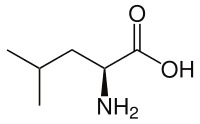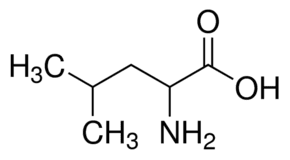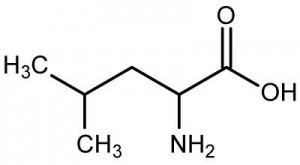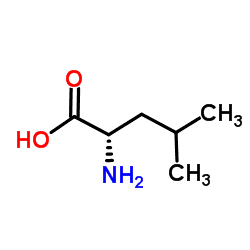Formula C6H13NO2 IUPAC ID Leucine | Molar mass 131.17 g/mol | |
Thermodynamic
data Phase behaviour
solid–liquid–gas | ||
All about leucine with lee labrada
Leucine (abbreviated as Leu or L; encoded by the six codons UUA, UUG, CUU, CUC, CUA, and CUG) is an α-amino acid used in the biosynthesis of proteins. It contains an α-amino group (which is in the protonated −NH+
3 form under biological conditions), an α-carboxylic acid group (which is in the deprotonated −COO− form under biological conditions), and an isobutyl side chain, classifying it as a nonpolar (at physiological pH) amino acid. It is essential in humans—meaning the body cannot synthesize it and thus must obtain from the diet.
Contents
- All about leucine with lee labrada
- Bodybuilding com guide to leucine
- Biology
- Biosynthesis in plants
- Metabolism in humans
- Effects
- Safety
- Chemical properties
- Other uses
- References

Leucine is a major component of the subunits in ferritin, astacin, and other "buffer" proteins.
Bodybuilding com guide to leucine
Biology

Leucine is used in the liver, adipose tissue, and muscle tissue. Adipose and muscle tissue use leucine in the formation of sterols. Combined leucine use in these two tissues is seven times greater than in the liver.
Biosynthesis in plants

Leucine is an essential amino acid in the diet of animals because they lack the complete enzyme pathway to synthesize it de novo from potential precursor compounds. Consequently, they must ingest it, usually as a component of proteins. Plants and microorganisms synthesize leucine from pyruvic acid with a series of enzymes:
Synthesis of the small, hydrophobic amino acid valine also includes the initial part of this pathway.
Metabolism in humans

In healthy individuals, approximately 60% of dietary L-leucine is metabolized after several hours, with roughly 5% (2–10% range) of dietary L-leucine being converted to β-hydroxy β-methylbutyric acid (HMB). Around 40% of dietary L-leucine is converted to acetyl-CoA, which is subsequently used in the synthesis of other compounds.

The vast majority of L-leucine metabolism is initially catalyzed by the branched-chain amino acid aminotransferase enzyme, producing α-ketoisocaproate (α-KIC). α-Ketoisocaproate is mostly metabolized by the mitochondrial enzyme branched-chain α-ketoacid dehydrogenase, which converts it to isovaleryl-CoA. Isovaleryl-CoA is subsequently metabolized by isovaleryl-CoA dehydrogenase and converted to β-methylcrotonoyl-CoA (MC-CoA), which is used in the synthesis of acetyl-CoA and other compounds. During biotin deficiency, HMB can be synthesized from MC-CoA via enoyl-CoA hydratase and an unknown thioesterase enzyme, which convert MC-CoA into β-hydroxy β-methylbutyryl-CoA (HMB-CoA) and HMB-CoA into HMB respectively. A relatively small amount of α-KIC is metabolized in the liver by the cytosolic enzyme 4-hydroxyphenylpyruvate dioxygenase (KIC dioxygenase), which converts α-KIC to HMB. In healthy individuals, this minor pathway – which involves the conversion of L-leucine to α-KIC and then HMB – is the predominant route of HMB synthesis.

A small fraction of L-leucine metabolism – less than 5% in all tissues except the testes where it accounts for about 33% – is initially catalyzed by leucine aminomutase, producing β-leucine, which is subsequently metabolized into β-ketoisocaproate (β-KIC), β-ketoisocaproyl-CoA, and then acetyl-CoA by a series of uncharacterized enzymes. HMB could be produced via certain metabolites that are generated along this pathway, but as of 2015 the associated enzymes and reactions involved are not known.
The metabolism of HMB is initially catalyzed by an uncharacterized enzyme which converts it to HMB-CoA. HMB-CoA is metabolized by either enoyl-CoA hydratase or another uncharacterized enzyme, producing MC-CoA or hydroxymethylglutaryl-CoA (HMG-CoA) respectively. MC-CoA is then converted by the enzyme methylcrotonyl-CoA carboxylase to methylglutaconyl-CoA (MG-CoA), which is subsequently converted to HMG-CoA by methylglutaconyl-CoA hydratase. HMG-CoA is then cleaved into to acetyl-CoA and acetoacetate by HMG-CoA lyase or used in the production of cholesterol via the mevalonate pathway.
Effects
Leucine is an mTOR activator. It is a dietary amino acid with the capacity to directly stimulate muscle protein synthesis. As a dietary supplement, leucine has been found to slow the degradation of muscle tissue by increasing the synthesis of muscle proteins in aged rats. However, results of comparative studies are conflicted. Long-term leucine supplementation does not increase muscle mass or strength in healthy elderly men. More studies are needed, preferably ones based on an objective, random sample of society. Factors such as lifestyle choices, age, gender, diet, exercise, etc. must be factored into the analyses to isolate the effects of supplemental leucine as a standalone, or if taken with other branched chain amino acids (BCAAs). Until then, dietary supplemental leucine cannot be associated as the prime reason for muscular growth or optimal maintenance for the entire population.
Leucine potently activates the mammalian target of rapamycin kinase that regulates cell growth. Infusion of leucine into the rat brain has been shown to decrease food intake and body weight via activation of the mTOR pathway. Several sensing mechanisms have been proposed; most recently, it has been demonstrated that sestrin 2 can directly bind to leucine and activate mTORC1 activity by promoting its localization to the lysosome.
Both L-leucine and D-leucine protect mice against seizures. D-leucine also terminates seizures in mice after the onset of seizure activity, at least as effectively as diazepam and without sedative effects. Decreased dietary intake of L-leucine promotes adiposity in mice. High blood levels of leucine are associated with insulin resistance in humans, mice, and rodents.
Safety
Leucine toxicity, as seen in decompensated maple syrup urine disease (MSUD), causes delirium and neurologic compromise, and can be life-threatening.
Excess leucine may be a cause of pellagra, whose main symptoms are "the four D's": diarrhea, dermatitis, dementia and death, though the relationship is unclear.
Leucine at a dose exceeding 500 mg/kg/d was observed with hyperammonemia. As such, the UL for leucine in healthy adult men can be suggested at 500 mg/kg/d or 35 g/d under acute dietary conditions.
Chemical properties
Leucine is a branched-chain amino acid (BCAA) since it possesses an aliphatic side-chain that is non-linear.
Racemic leucine had been subjected to circularly polarized synchrotron radiation to better understand the origin of biomolecular asymmetry. An enantiomeric enhancement of 2.6% had been induced, indicating a possible photochemical origin of biomolecules' homochirality.
Other uses
As a food additive, L-leucine has E number E641 and is classified as a flavor enhancer.
